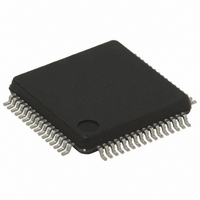ST72F321BAR6T6 STMicroelectronics, ST72F321BAR6T6 Datasheet - Page 25

ST72F321BAR6T6
Manufacturer Part Number
ST72F321BAR6T6
Description
MCU 8BIT 32KB FLASH/ROM 64-LQFP
Manufacturer
STMicroelectronics
Series
ST7r
Datasheet
1.ST72F321BK6T6.pdf
(187 pages)
Specifications of ST72F321BAR6T6
Core Processor
ST7
Core Size
8-Bit
Speed
8MHz
Connectivity
I²C, SCI, SPI
Peripherals
LVD, POR, PWM, WDT
Number Of I /o
48
Program Memory Size
32KB (32K x 8)
Program Memory Type
FLASH
Ram Size
1K x 8
Voltage - Supply (vcc/vdd)
3.8 V ~ 5.5 V
Data Converters
A/D 16x10b
Oscillator Type
Internal
Operating Temperature
-40°C ~ 85°C
Package / Case
64-LQFP
Processor Series
ST72F3x
Core
ST7
Data Bus Width
8 bit
Data Ram Size
1 KB
Interface Type
I2C, SCI, SPI
Maximum Clock Frequency
8 MHz
Number Of Programmable I/os
48
Number Of Timers
2
Maximum Operating Temperature
+ 85 C
Mounting Style
SMD/SMT
Development Tools By Supplier
ST7232X-EVAL, ST7232X-SK/RAIS, ST72321B-D/RAIS, ST7MDT20-DVP3, ST7MDT20J-EMU3, ST7MDT20M-EMU3, STX-RLINK
Minimum Operating Temperature
- 40 C
On-chip Adc
10 bit, 16 Channel
For Use With
497-5046 - KIT TOOL FOR ST7/UPSD/STR7 MCU
Lead Free Status / RoHS Status
Lead free / RoHS Compliant
Eeprom Size
-
Lead Free Status / Rohs Status
Details
Other names
497-5582
Available stocks
Company
Part Number
Manufacturer
Quantity
Price
Company:
Part Number:
ST72F321BAR6T6
Manufacturer:
STMicroelectronics
Quantity:
10 000
6.2 MULTI-OSCILLATOR (MO)
The main clock of the ST7 can be generated by
three different source types coming from the multi-
oscillator block:
■
■
■
Each oscillator is optimized for a given frequency
range in terms of consumption and is selectable
through the option byte. The associated hardware
configurations are shown in
electrical characteristics section for more details.
Caution: The OSC1 and/or OSC2 pins must not
be left unconnected. For the purposes of Failure
Mode and Effect Analysis, it should be noted that if
the OSC1 and/or OSC2 pins are left unconnected,
the ST7 main oscillator may start and, in this con-
figuration, could generate an f
in excess of the allowed maximum (>16MHz.),
putting the ST7 in an unsafe/undefined state. The
product behaviour must therefore be considered
undefined when the OSC pins are left unconnect-
ed.
External Clock Source
In this external clock mode, a clock signal (square,
sinus or triangle) with ~50% duty cycle has to drive
the OSC1 pin while the OSC2 pin is tied to ground.
Crystal/Ceramic Oscillators
This family of oscillators has the advantage of pro-
ducing a very accurate rate on the main clock of
the ST7. The selection within a list of 4 oscillators
with different frequency ranges has to be done by
option byte in order to reduce consumption (refer
to
frequency ranges). In this mode of the multi-oscil-
lator, the resonator and the load capacitors have
to be placed as close as possible to the oscillator
pins in order to minimize output distortion and
start-up stabilization time. The loading capaci-
tance values must be adjusted according to the
selected oscillator.
These oscillators are not stopped during the
RESET phase to avoid losing time in the oscillator
start-up phase.
section 14.1 on page 174
an external source
4 crystal or ceramic resonator oscillators
an internal high frequency RC oscillator
for more details on the
Table
OSC
clock frequency
5. Refer to the
ST72321BRx, ST72321BARx ST72321BJx, ST72321BKx
Internal RC Oscillator
This oscillator allows a low cost solution for the
main clock of the ST7 using only an internal resis-
tor and capacitor. Internal RC oscillator mode has
the drawback of a lower frequency accuracy and
should not be used in applications that require ac-
curate timing.
In this mode, the two oscillator pins have to be tied
to ground.
Table 5. ST7 Clock Sources
C
L1
Hardware Configuration
EXTERNAL
SOURCE
OSC1
OSC1
OSC1
CAPACITORS
LOAD
ST7
ST7
ST7
OSC2
OSC2
OSC2
C
L2
25/187














